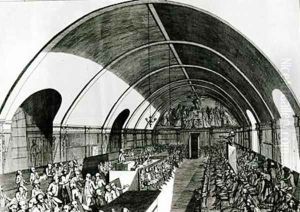Louis Joseph I Masquelier Paintings
Louis Joseph Masquelier, born in 1741 and deceased in 1811, was a distinguished French engraver whose work spanned the late 18th and early 19th centuries. Masquelier's contributions to the art world were marked by his exceptional skill in the intricate craft of engraving, a technique that played a crucial role in the dissemination of visual culture during his time. His career unfolded during a period of significant upheaval and transformation in France, encompassing the Ancien Régime, the French Revolution, and the Napoleonic era. Despite the turbulent social and political environment, Masquelier managed to navigate these changes, adapting his art to meet the evolving tastes and demands of the period.
Masquelier was part of a family deeply entrenched in the arts, with several members engaged in various artistic pursuits. This environment undoubtedly nurtured his talents and passion for the arts from a young age. He trained under notable masters of his time, honing his technique and developing a distinctive style that would make his works sought after by publishers and collectors. His engravings covered a wide range of subjects, including portraits, landscapes, historical scenes, and illustrations for books, contributing significantly to the popularization of these genres in print form.
Throughout his career, Masquelier collaborated with prominent artists and intellectuals of his era, engraving works based on their paintings or drawings. This collaboration was a testament to his mastery and reputation in the artistic community, allowing him to leave an indelible mark on the visual arts landscape of his time. His engravings not only served as valuable artistic creations but also as important documents of cultural and historical significance, capturing the aesthetic and ideological shifts of his era.
Despite his contributions, Louis Joseph Masquelier's name might not be as widely recognized today outside of specialized art historical circles. However, his work remains an essential part of the study of French engraving and the broader history of European art. His legacy is preserved in the collections of major museums and galleries, where his engravings continue to be appreciated for their technical excellence and historical value. Masquelier’s life and work exemplify the role of the engraver in the early modern period, bridging the gap between artists and a growing audience eager for access to visual culture.
